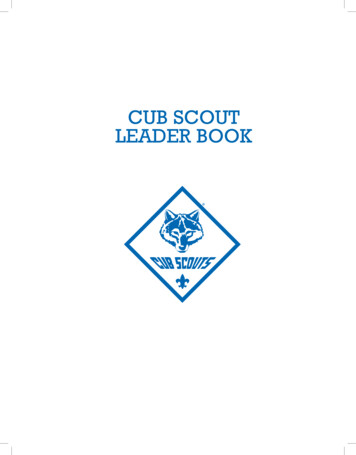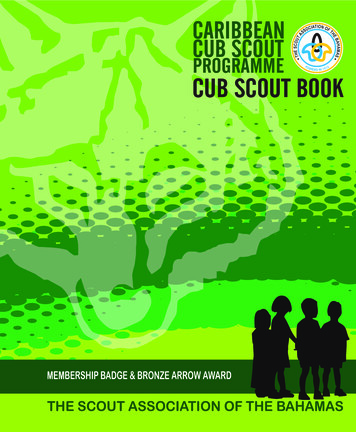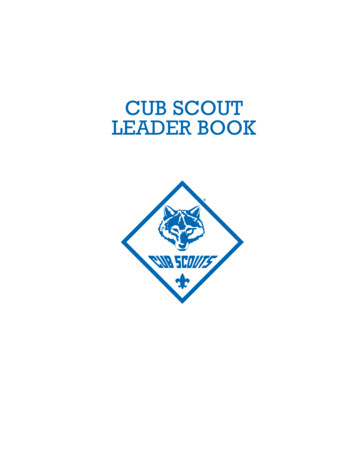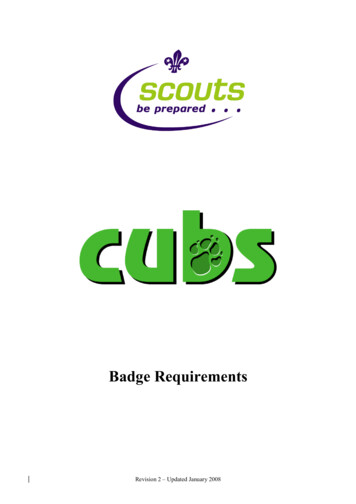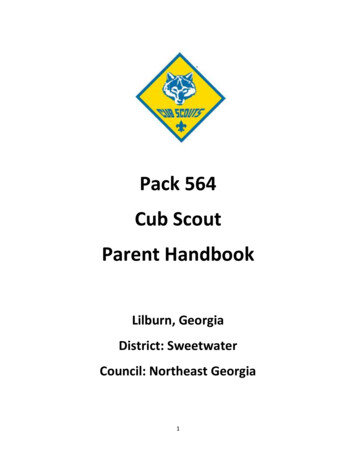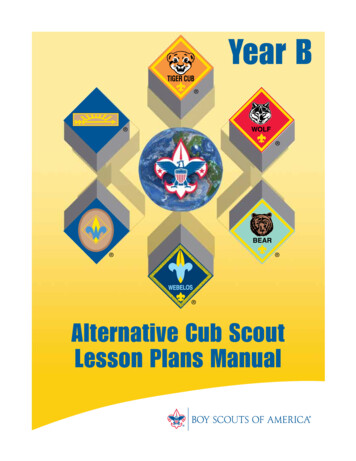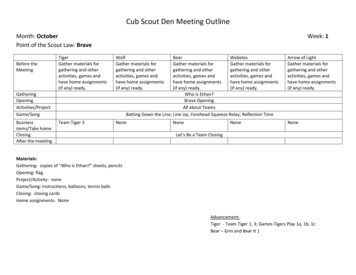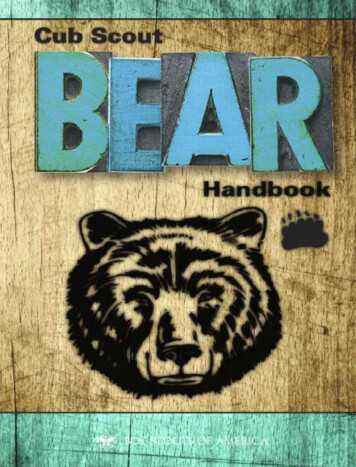
Transcription
Welcome to the BEARHandbook
Table of ContentsBEAR PARENT INTRODUCTIONUsing This HandbookYour Son, Scouting, and YouThe Purposes of Cub ScoutingCub Scout DenCub Scout Pack LeadershipYour Bear’s AdvancementDo Your BestBear BadgeScouting and Duty to GodWELCOME, BEAR!Cub ScoutingYour Bear LeadersYour Bear Den and Den M eetingsYour Pack M eetings
Your Bear UniformCharacter CompassThe Outdoor CodeLeave No Trace Principles for KidsYOUR FIRS T RANK—BOBCAT!THE BEAR ADVENTURES AND REQUIREMENTSBEAR REQUIRED ADVENTURESBear ClawsBear NecessitiesFellowship and Duty to God
Fur, Feathers, and FernsGrin and Bear ItPaws for ActionBEAR ELECTIVE ADVENTURESBaloo the BuilderA Bear Goes FishingBear Picnic BasketBeat of the DrumCritter CareForensicsM ake It M oveM arble M adnessRoaring LaughterRoboticsSalmon RunSuper ScienceA World of SoundSpecial Awards You Can EarnBobcat Trail
Bear Adventure TrackingGet Set for the Webelos Adventures!
If you could give only one gift to your son, what would it be?No matter what your family situation, it is within your power tohelp him grow into a person with a good feeling about himself anda genuine concern for others. Cub Scouting can assist you inproviding this greatest gift of all.Today your son is a Bear, but soon he will graduate into aWebelos den. He’ll then work to achieve the Webelos and Arrow ofLight ranks. This will prepare him for more adventure as a BoyScout and the opportunity to earn Scouting’s highest rank—EagleScout.Using This HandbookThis handbook is written for both you and your Bear. M uch ofit is for your son to enjoy, while other sections like this parentinformation are for you. However, it is our hope that you will readthe adventures along with your Bear and help him to achieve them.
Your Son, Scouting, and YouAs a parent or other caring adult, you want your Bear to growup to be self-reliant and dependable, worthy and caring. Scoutinghas these same goals in mind for him.The mission of the Boy S couts of America is to prepareyoung people to make ethical and moral choices over theirlifetimes by instilling in them the values of the S cout Oathand S cout Law.
The S cout Oath and the S cout Law are defined on pages18–21 in the Bobcat requirements.Since 1910, the Boy Scouts of America has been weavinglifetime values into fun, developmental activities. These activitiesare designed to help families teach their sons how to make gooddecisions throughout their lives and give them confidence as theybecome the adult leaders of tomorrow.In a society where your son is often taught that winning iseverything, Cub Scouting teaches him to DO HIS BEST, to helpothers, and to try to live his life according to the Scout Oath andthe Scout Law. If a Cub Scout has done his best to satisfy arequirement, then he has met the standard for advancement in CubScouts. It is up to his parent and den leader to gauge whether hehas offered his best effort.The Purposes of Cub ScoutingCub Scouting is a year-round family-oriented part of the BSA
program designed for boys who are in first through fifth grades (orare 7, 8, 9, and 10 years old). Parents, leaders, and organizationswork together to achieve the Purposes of Cub Scouting.1. Character Development2. Spiritual Growth3. Good Citizenship4. Sportsmanship and Fitness5. Family Understanding6. Respectful Relationships7. Personal Achievement8. Friendly Service9. Fun and Adventure10. Preparation for Boy Scouts
Cub Scout DenYour Cub Scout is a member of a den. The Bear den will involveyour son in a group of boys his own age where he can earnrecognition for his accomplishments. He will also gain a sense ofpersonal achievement from the skills he learns. M ost dens have sixto eight boys and meet two to three times a month. Den meetingsare a time for learning new things, having fun, and going on outings.
Dens are led by a team of adult volunteers—the den leader andassistant den leader(s).Cub Scout Pack LeadershipYour Bear is also a member of a Cub Scout pack. M ost packsare made up of several dens that gather monthly at a pack meeting.The meeting usually follows a suggested theme, and it’s a time forboys to be recognized for their accomplishments during the month,to perform skits and songs they have learned in den meetings, andto have fun with the entire family.Packs are led by a Cubmaster and pack committee. Like the denleaders, the Cubmaster and assistants are volunteer leaders—usually family members of boys in the pack. The pack committeemakes plans for pack meetings and activities and takes care of the“business” items that are necessary for a pack to operatesmoothly.Each pack is sponsored by a chartered organization. This is acommunity organization that has applied for and received a charterfrom the Boy Scouts of America National Council to operate theScouting program. The chartered organization may be a school,service club, religious group, or other group interested in youth.The chartered organization sponsors the pack, approves theleadership of the pack, provides a meeting place, and operates thepack within the guidelines and policies of that organization and theBoy Scouts of America.
Your Bear’s AdvancementIn Scouting, advancement is the process by which a membermeets certain requirements and earns recognition. The Bearadvancement program is a blend of activities that boys complete intheir den meetings as well as at home with their families.If your son is a new Cub Scout, the first step in theadvancement process is to earn the Bobcat badge (see page 16).The Bobcat requirements serve to orient a new Scout to the idealsand symbols of Scouting. When all of the Bobcat requirementshave been completed, your boy becomes eligible to receive hisBobcat badge in a pack ceremony.
As a Bear, your son will work toward earning the Bear rank.This rank is for those boys who are in the third grade or are 9 yearsold. All the Cub Scout ranks (Tiger, Wolf, Bear, Webelos, and
Arrow of Light) are tailored for a grade and the corresponding agelevel. To advance, Bears work on the adventures described in thishandbook, some required and some elective. As your soncompletes each requirement in an adventure to the best of hisability, you or another caring adult will sign the space marked“Akela’s OK.” His den leader will sign where it says, “DenLeader’s OK.” If the requirement is completed in a den meeting,the den leader may sign both places.Akela means “good leader” and is an important part of CubScouting. Akela can be you, a den leader, a teacher, or anotherimportant adult. Scouts can track their requirements in the BearAdventure Tracking section found at the back of the book. As boysadvance, they earn adventure loops and pins to mark theirprogress. These items will be presented to them during a ceremonyat a pack or den meeting. It is important for boys to be recognizedfor the good work they do.Do Your BestYour Bear can keep track of his adventures using the BearAdventure Tracking on page 291 of this handbook. This providesencouragement and helps him see his progress toward the Bearrank. Whenever possible, adventure requirements are written in a
way that allows them to be customized for each boy and den.Boys are never “tested” or placed in a position where they maynot be successful. If a Cub Scout has participated and done his bestto satisfy a requirement, then he has met the standard foradvancement in Cub Scouts. It is up to his parent and den leader togauge whether he has offered his best effort.If a Bear is unable to participate in a den or pack activity due toan illness or conflict, you may work with him to complete therequirements to the best of his ability, but please make every effortto help him attend each meeting so he can get the full benefit of theCub Scouting program.If your Bear has an intellectual or physical disability thatprevents him from attempting a requirement, talk to your denleader and Cubmaster about finding an alternative.Bear BadgeThe Bear badge is awarded when boys have completed thefollowing:
1. Complete each of the following Bear required adventures withyour den or family:2. Complete one Bear elective adventure of your den or family’schoosing.3. With your parent or guardian, complete the exercises in thepamphlet How to Protect Your Children From Child Abuse: AParent’s Guide, and earn the Cyber Chip award for your age.*
*If your family does not have Internet access at home AND you do not haveready Internet access at school or another public place or via a mobile device,the Cyber Chip portion of this requirement may be waived by your parent orguardian.Family participation is an integral part of the advancementprocess, and there are many chances to join in activities that areage-appropriate for your child. You may sign the “Akela’s OK” inhis handbook each time he finishes a requirement, and you shouldalways notify the den leader when a requirement is completed athome.The Bear badge is presented during a special ceremony at apack meeting to each boy’s parent or guardian, who in turnpresents it to the Scout. The badge is worn on the left uniformpocket. (See page 12 or inside the back cover.)Scouting and Duty to GodThe Boy Scouts of America has always held steadfastly to theprinciple, embodied in the Scout Oath, that a Scout has a duty toGod. The BSA does not promote any specific religion, and hasalways embraced all faiths. We do encourage youth members andtheir families to be active in their own faith, in keeping with theBSA’s Declaration of Religious Principle.It naturally follows that the leadership for your son’s spiritualdevelopment, both within and outside Cub Scouting, must comeprimarily from your home and your family’s religious leaders. Yourson will look to you as his example of how to learn and perform
his duty to God.The adventures related to duty to God in each rank of the CubScouting program provide support, and each boy has theopportunity to earn the religious emblem of his faith. The emblemis created and presented by your son’s religious group. M ost of theworld’s religions have an emblem of their faith. However,alternative requirements are available for boys whose faithinstitutions do not have an emblem or whose families are notaffiliated with an organized religious group.In addition, the staff at your BSA local council service centershould be able to help. M any local councils and districts offerorganized opportunities for Scouts to earn their religious emblemswhile meeting and sharing fellowship with other Scouts of theirfaith.
You can also find information on the Internet atwww.praypub.org orwww.scouting.org/filestore/pdf/512-879 WB.pdf.
Welcome to a fun and exciting year of Cub Scouting, Bear! Youwill go on adventures, exploring the world around you with otherBears in your den. You will play games, make fun things, learnabout wildlife, and spend lots of time outdoors. Best of all, you’lleven earn awards while having all this fun.Cub ScoutingDo you know how many years Cub Scouting has been around?Cub Scouting began in 1930, which means it is now more than 80years old. Can you imagine how many boys have been Cub Scoutsin all those years? If you said “tens of millions,” you would beright.Lord Baden-Powell founded the Scouting movement in 1907.Over time, a program developed to include younger boys.
Baden-Powell liked the stories in The Jungle Book by RudyardKipling, and he thought many of the characters were fun andplayful, just like Cub Scouts. He also knew it was important forthe boys to have a wise leader like Akela, the wolf. Akela letsM owgli, the boy, join the wolf pack. M aybe you also know aboutBaloo the bear, who helps teach M owgli the laws of the jungle sohe can live among the animals. To this day, we have names likeAkela and Baloo, and words like den and pack, in Cub Scouting.That’s our way of remembering how Cub Scouting began with TheJungle Book.
Your Bear LeadersAs a Bear Scout, you have several people who you can call“Akela.” These include the den leader, the assistant den leader, andyour parent or guardian. Akela can be anyone who is older thanyou and a wise teacher, just like Akela in The Jungle Book. Theseleaders help you to learn new things, and they can even help youfind new ways to use what you have already learned! Akela willalso sign your adventure requirements in the handbook when youcomplete them.
Did you know you can also help lead your den by becoming aBear denner? The denner is a Scout chosen by the members of hisden to help the den leader and den chief at meetings and outings.He serves for about one to two months. If you’re elected to be thedenner, do your best.Your Bear Den and Den MeetingsBeing a Bear in the Boy Scouts of America means that you
belong to a den of boys who are Bears just like you! These boysare in the same grade or are the same age as you, and you all cometogether in “den meetings” a few times a month. In these meetingsyou will work on the Bear adventures, earning awards, playinggames, and making fun things with the rest of the den.Your Pack MeetingsYou, your family, and your den also go to a monthly packmeeting. This is a meeting for all the boys in all the dens in thepack to get together at the same time. It’s a chance to tell othersabout the hard work your den has done on the adventure thatmonth, and also a time for awards and seeing what other Scouts inthe pack are doing, at all different rank levels!Your Bear UniformYour uniform is an important part of being a Cub Scout.Wearing it lets people know that you belong to a Bear den and apack and, most important, you belong to the Boy Scouts ofAmerica! You should wear the uniform to den meetings, packmeetings, and any special activities you participate in as a Bear.The official uniform for Cub Scouts includes blue Cub Scoutpants or shorts and shirt with insignia for your rank. Each rank hasits own neckerchief and slide in the rank colors and a belt buckle tobe worn with the blue Cub Scout belt. Bear Scouts can also wear an
official navy-blue cap with a light blue front panel and Bearemblem. When you wear the full Cub Scout uniform, it shows youare a member of the team.
The pictures below show you where to put the Bear Scoutinsignia on the sleeves and pockets of your uniform.You might receive an emblem for participating in day camp or acouncil popcorn sale. This is an example of “temporary insignia”and should be worn centered on the right pocket.
The denner wears gold shoulder cords suspended from the leftshoulder of his uniform. The cords are removed when his time asthe denner ends.
Character CompassAs you work on your Bear adventures in your Bear Handbook,you will notice this symbol:A compass is a tool that guides a person from place to place.Character is how we act, and it guides our entire lives. Thiscompass will be your guide to one or more of the 12 points of theScout Law. Every time you check the compass, it will remind youof how the activities in each adventure are related to the Scout Law.This may also help you think about how the points of the ScoutLaw guide our way in Cub Scouting and in daily life. Those pointsare all different, and each one is a treasure for you to find!The Outdoor CodeM uch of Scouting, including Cub Scouting, happens outside.For more than 60 years, the Outdoor Code has been a guide for
Scouts in the outdoors. Remember to do your best by showingrespect for the outdoors and by learning and upholding theOutdoor Code.
THE OUTDOOR CODEAs an American, I will do my best to—Be clean in my outdoor manners,Be careful with fire,Be considerate in the outdoors, andBe conservation-minded.Being clean in your outdoor manners, careful with fire, andconsiderate means you can enjoy the outdoors in ways that do no
harm to the environment. Being conservation-minded encouragesthe protection and thoughtful use of natural resources and doingyour part to improve the condition of the land and theenvironment.As a Cub Scout, you will learn to use the Leav e No TracePrinciples for Kids to help you take care of an area where you hikeor camp.Leave no Trace Principles for Kids*1. Know Before You Go. Find out about the place you’re going tocamp ahead of time. Are there rules you need to know about?Are any activities against the rules? Is water available? Do youneed to bring anything special?2. Choose the Right Path. Always walk on trails, even if thatmeans getting your boots muddy. Don’t take shortcuts. Set uptents in marked camping areas.3. Trash Your Trash. Use bathroom facilities when available.
Follow campground rules for handling dishwater. Pack out allyour trash unless the campground has trash pickup.4. Leave What You Find. Leave any natural treasures where youfind them so other campers can enjoy them, too. If you want asouvenir of your campout, take a picture. A good saying toremember is “Leave nothing but footprints, take nothing butpictures, kill nothing but time.”5. Be Careful With Fire. Cook on a camp stove or grill wheneverpossible. It’s easier and less messy than cooking over an openfire. Only build fires in designated fire rings. Always havesomeone keep an eye on your fire until it is dead out.6. Respect Wildlife. Travel quietly and give animals enough spacethat you don’t disturb them. Getting too close to an animal canpotentially hurt the animal and you. Take pictures from a safedistance. You’re visiting the animal’s home, so be considerate.7. Be Kind to Other Visitors. Be respectful of other visitors bykeeping noise down and not entering other groups’ campsiteswithout permission. Be polite to other people you meet. Give
them the respect you expect from them.To help you remember the Outdoor Code and the Leave NoTrace Principles for Kids, you can find them in the back of yourhandbook.*The member-driven Leave No Trace Center for Outdoor Ethics teaches peoplehow to enjoy the outdoors responsibly. This copyrighted information has beenreprinted with permission from the Leave No Trace Center for OutdoorEthics: www.LNT.org.
If you haven’t already earned your Bobcat badge, you will needto start your Cub Scouting adventures by learning what it takes tobecome a Bobcat.Read through the Bobcat requirements and practice severaltimes what you have learned. When you think that you are ready,share what you’ve learned with your family, your den leader, andwith your den at a pack meeting. Then give yourself a pat on theback and congratulate yourself on earning your Bobcat badge.
BOBCAT REQUIREMENTS1. Learn and say the S cout Oath, with help ifneeded.2. Learn and say the S cout Law, with help ifneeded.3. S how the Cub S cout sign. Tell what it means.4. S how the Cub S cout handshake. Tell what itmeans.5. S ay the Cub S cout motto. Tell what it means.6. S how the Cub S cout salute. Tell what itmeans.7. With your parent or guardian, complete theexercises in the pamphlet How to Protect YourChildren From Child Abuse: A Parent’s Guide.
1 Learn and say the Scout Oath, with help ifneeded.One of the most important parts of that is to understand thatall members of the Boy Scouts of America believe in, live by, andoften repeat the Scout Oath and the Scout Law. We learn thosewords and believe in them as a way to live our lives and be goodmembers of our families, our communities, and the Boy Scouts ofAmerica!S cout OathOn my honor I will do my bestTo do my duty to God and my countryand to obey the S cout Law;To help other people at all times;To keep myself physically strong,mentally awake, and morally straight.The Meaning of the S cout OathOn My Honor I Will Do My Best
Saying “On my honor” is like saying “I promise.” It means thatyou will do your best to do what the Scout Oath says.
The S cout Oath has three promises. Let’s look at what theymean.To Do My Duty To God and My Country and ToObey The Scout LawA duty is something you are expected to do. At home, youmight be expected to make up your bed or take out the trash. Youalso have duties to God and to your country. You do your duty toGod by following the teachings of your family and religiousleaders. You do your duty to your country by being a good citizenand obeying the law. You also promise to live by the 12 points ofthe Scout Law, which are described on the next page.To Help Other People at All TimesM any people need help. A friendly smile and a helping handmake life easier for others. By helping other people, you are doinga Good Turn and making our world a better place.To Keep Myself Physically Strong, MentallyAwake, and Morally StraightThe last part of the Scout Oath is about taking care of yourself.You stay physically strong when you eat the right foods and getplenty of exercise. You stay mentally awake when you work hard
in school, learn all you can, and ask questions. You stay morallystraight when you do the right thing and live your life withhonesty.
2 Learn and say the Scout Law, with help ifneeded.S cout LawA S cout is trustworthy, loyal, helpful, friendly, courteous,kind, obedient, cheerful, thrifty, brave,clean, and reverent.The Meaning of the S cout LawThe Scout Law has 12 points. Each is a goal for every Scout.He does his best to live up to the Law every day. It is not alwayseasy to do, but a Scout always tries.
3 Show the Cub Scout sign. Tell what itmeans.M ake the sign with your right hand. Hold your arm straight up.The two raised fingers stand for the Scout Oath and the Scout Law.The fingers look like the sharp ears of the wolf ready to listen toAkela! Remember that Akela means “good leader” to a Cub Scout.Your mother or father or guardian is Akela. So is your Cubmasteror your den leader. At school, your teacher is Akela.
4 Show the Cub Scout handshake. Tell whatit means.When you shake hands with another Cub Scout, do this: Holdout your right hand just as you always do to shake hands. But thenput your first two fingers along the inside of the other boy’s wrist.This means that you help each other to remember and obey theScout Oath and Scout Law.
5 Say the Cub Scout motto. Tell what itmeans.The Cub S cout motto is “Do Your Best.”A motto is a guiding principle and a rule for living. Do YourBest means trying your hardest, not just a little bit. Do your bestall the time. Do your best in school and at home. Do your bestwhen you play a game and help your team. Do your best as youwork on your rank adventures!
6 Show the Cub Scout salute. Tell what itmeans.Salute with your right hand. Hold your first two fingers closetogether. Touch your fingertips to your cap. If you aren’t wearing acap, touch your right eyebrow. You salute the flag to show respectto our country. Always use the Cub Scout salute when you are inyour Cub Scout uniform, both indoors and outdoors. If you are notin uniform, you salute the flag by placing your right hand overyour heart.
7 With your parent or guardian, completethe exercises in the pamphlet How to ProtectYour Children from Child Abuse: A Parent’sGuide.If your handbook does not include the pamphlet, talk with yourden leader.Congratulations on earning your Bobcat badge! You may nowcontinue on the trail of your Bear adventures! Let’s take a look atwhat those adventures are called, what you need to do to earn yourBear badge, and all the fun things you will explore as a Bear.
Bear Rank Requirements1. Complete each of the following Bear required adventures withyour den or family:2. Complete one Bear elective adventure of your den or family’schoosing. (See page 29.)3. With your parent or guardian, complete the exercises in thepamphlet How to Protect Your Children from Child Abuse: AParent’s Guide and earn the Cyber Chip award for your age.**If your family does not have Internet access at home AND you do not haveready Internet access at school or another public place or via a mobile device,
the Cyber Chip portion of this requirement may be waived by your parent orguardian.Once you have achieved all of the Bear rank badge requirementsand your handbook has been signed, you are ready to earn yourBear badge! Let out a big GRAND HOWL, Bear Scout!
Bear Required Adventures
Snapshot of AdventureA pocketknife is a useful tool to have for S coutingactivities. It can also be dangerous if you don’t use it the rightway. In this adventure, you will learn how to use apocketknife safely. You will also get to learn the basics ofcarving.A Scout is trustworthy. You can show that you aretrustworthy by taking care of your pocketknife andusing it safely.
REQUIREMENT 1 Learn about three commondesigns of pocketknives.
Pocketknives come in all shapes and sizes. Some can be usedfor many different tasks. Others are designed for special purposeslike fishing.Three common designs used in Scouting are the jackknife, thepenknife, and the multipurpose knife. Let’s look at each type.JackknifeA jackknife is a good tool for campers and fishermen. It ishinged at only one end and may have one or two blades. Sometimesone blade has a very sharp point, while another blade has a morerounded point.Some jackknives (and other knives) have locking blades. Thatmeans you have to push a release before you can close the blade.
Locking blades prevent you from accidentally closing the blade onyour fingers.PenknifeA penknife is small and lightweight, so it is easy to carry inyour pocket. It is hinged at both ends and usually has one or twoblades at each end. Penknives were originally designed to cut orsharpen quills used for writing. Thomas Jefferson wrote theDeclaration of Independence with a quill pen.
Multipurpose KnifeM ultipurpose knives can be used to do many things. Inaddition to one or two blades, a multipurpose knife might include acan opener, scissors, leather punch, tweezers, and screwdrivers.
These knives can be fun to have, but all those extra pieces canget in your way when you are just trying to carve or cut somestring. Also, the more tools your knife includes, the heavier it will
be. Pick a multipurpose knife that has only the tools you reallyneed.
REQUIREMENT 2 Learn knife safety and earn yourWhittling Chip.**One of the items carved for Bear Claws requirement 3 may be used to fulfillWhittling Chip requirement 3.It is very important to be safe when you use your pocketknife.
In this requirement, you will learn the rules of knife safety and earnyour Whittling Chip. When you have earned your Whittling Chip,you will be allowed to carry your pocketknife to designated CubScout activities. Your parent or den leader will tell you when youmay bring your knife. Always keep your Whittling Chip card withyou when you are carrying your knife.A Scout is obedient. When you follow the rules of knifesafety, you keep yourself from getting hurt and youshow that you are obedient.Knife Safety Rules to Learn and Live ByA knife is a tool, not a toy.Know how to sharpen a knife. A sharp knife is safer than adull knife because it is less likely to slip and cut you.
Keep the blade clean and dry.Never carry an open pocketknife.When you are not using your knife, close it using the palmof your hand and put it away.When you are using the cutting blade, do not try to make bigshavings or chips. Cut slowly and steadily.M ake a safety circle. Before you pick up your knife to useit, stretch your arm out and turn in a circle. If you cannottouch anyone or anything else, it is safe to use your knife.While using your knife, be sure to watch in case someonewalks toward you and gets too close. If that happens, putyour knife away until it is safe to continue.Always cut away from you, never toward you.Never hand a knife to someone else blade first. Learn and usethe “eye contact” method of handing a knife to someoneelse. Do not release the knife until the other person makeseye contact with you and acknowledges he is receiving theknife.
Never use a knife on something that will dull or break it.Never throw a knife for any reason.Always think before you cut. Do not use your knife to stripbark from a tree or to carve your initials into something thatdoes not belong to you.
Once you understand the safety rules, agree to abide by thePocketknife Pledge, and have your den leader sign your card, youwill have earned your Whittling Chip.
POCKETKNIFE PLEDGEI understand the reason for safety rules.I will treat my pocketknife with the respect due auseful tool.I will always close my pocketknife and put it away whenI am not using it.I will not use my pocketknife when it might injuresomeone near me.I promise never to throw my pocketknife for anyreason.I will use my pocketknife in a safe manner at all times.Keeping Your Knife SharpA good way to sharpen your knife is to use a sharpening stone.Lay the blade on the stone at a slight angle. Push the blade forwardas if you were going to shave a thin sliver from the stone. Do notpush down hard. Next, turn the blade over and shave the stonetoward you. This is the only time you should move your knifetoward yourself. Keep your fingers below the surface of the stone
to protect them. Continue this back-and-forth action until the edgeis sharp along its entire length.Making Stop CutsHere is a secret to use when you are whittling. Before you makea shaving cut, make a stop cut. At the place you want the shavingto stop, cut straight down with your knife. Press down and rockthe blade back and forth until the cut is as deep as you want theshaving to go. This stop cut will prevent you from shaving off toomuch wood.
First Aid for Knife CutsAccidents can happen even when you are being careful. It isimportant that you know what to do if you or one of your fellowScouts gets cut while using a pocketknife.Small cuts in the skin can allow bacteria to enter the body andcause infection. Wash minor cuts with soap and water. Applyantibiotic ointment and cover with a dry, sterile dressing or anadhesive bandage to help prevent infection and protect the wound.Clean
Cub Scout Den Your Cub Scout is a member of a den. The Bear den will involve your son in a group of boys his own age where he can earn recognition for his accomplishments. He will also gain a sense of personal achievement from the skills he learns. Most dens have six to eight boys and meet two to three times a month. Den meetings
